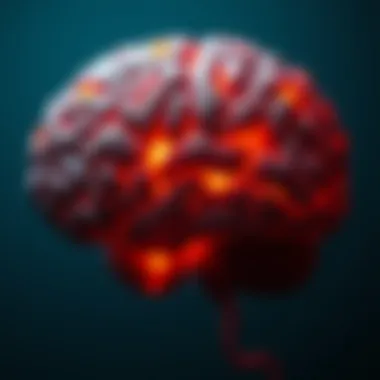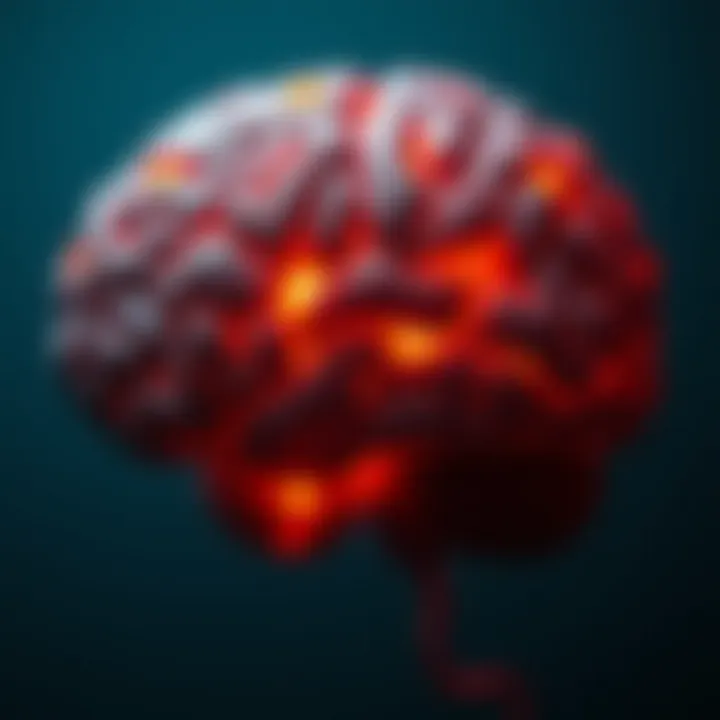Understanding Panic Disorder: Comprehensive Insights


Intro
Panic disorder is a profound mental health issue that can impede daily life, casting long shadows over moments that should otherwise be normal. Often misunderstood, this condition manifests through sudden bouts of fear and discomfort, leading individuals to feel as though they are losing control, experiencing heart palpitations, or even facing impending doom. However, digging deeper into panic disorder goes beyond merely recognizing symptoms; it involves understanding the very fabric of mental health itself.
Understanding Mental Health and Well-being
What is Mental Health?
Mental health encapsulates our emotional, psychological, and social well-being. It dictates how we think, act, and relate to others, ultimately shaping our life experiences. Mental health is not static; it can change with circumstances, life events, and even biological factors. This fluidity signifies that prioritizing mental health is essential for a fulfilling life.
The Importance of Prioritizing Mental Well-being
Prioritizing mental well-being is not just a trend; it’s an essential life skill. When individuals understand their mental health, they can identify challenges before they spiral. Awareness often fosters proactive management, leading to significant improvements in life quality.
Common Mental Health Challenges and Disorders
While panic disorder is a significant mental health challenge, it's one of many. Anxiety disorders, depression, and more intricate issues like obsessive-compulsive disorder (OCD) can coexist and complicate situations. Acknowledging the complexities of mental health can lead to better outcomes and more tailored approaches to treatment.
Strategies for Improving Mental Health
Self-care Techniques and Practices
Self-care isn’t just indulgence; it's an essential practice. Engaging in activities that nurture your mind and body is crucial. Consider developing hobbies or practice mindfulness to enhance your mental well-being. This can include meditation, physical activity, or even spending time in nature to rejuvenate the spirit.
Building Resilience and Stress Management
Building resilience can turn obstacles into pathways. Resilience involves adapting well in the face of adversity, trauma, or stress. Techniques like cognitive re-framing can aid in shifting perspectives and finding constructive paths forward.
Seeking Professional Help: Therapy and Counseling
Navigating panic disorder often benefits from professional guidance. Therapies, including Cognitive Behavioral Therapy (CBT), provide valuable tools to combat panic episodes. Hence, reaching out to a therapist isn’t a sign of weakness but a commendable step toward healing.
Finding Balance in Life
Healthy Lifestyle Choices: Diet, Exercise, and Sleep
Diet and exercise play pivotal roles in mental health. Eating wholesome foods fuels not just the body but also the mind, while regular physical activity can alleviate symptoms of anxiety and depression. Furthermore, sleep is paramount; poor sleep can exacerbate feelings of anxiety and despair.
Mindfulness and Meditation Practices
Incorporating mindfulness can bring harmony to chaotic thoughts. Mindfulness techniques can ground individuals, fostering a sense of presence and awareness. Meditation, even for short periods, can transform mental clarity and reduce anxiety.
Setting Boundaries and Managing Time Effectively
Managing time and setting boundaries is often overlooked yet vital for mental well-being. Learning to say no or delegating tasks can lighten burdens. It enables focus on what truly matters, thus creating space for rest and rejuvenation.
Enhancing Personal Development
Goal Setting and Productivity Tips
Setting achievable goals is fundamental to personal growth. Break goals down into smaller, manageable tasks to avoid feeling overwhelmed. Tracking progress can maintain momentum and provide motivation.
Building Healthy Relationships and Social Connections
Relationships are pillars of support during tough times. Investing time in nurturing relationships—whether with family, friends, or community—can provide emotional sustenance and reassurance.
Practicing Gratitude and Positivity
A daily practice of gratitude can reshape your outlook. Reflecting on positive aspects of life—even amidst challenges—can cultivate a richer, more optimistic perspective.
Tips for Maintaining Mental Well-being
Strategies for Preventing Burnout
Preventing burnout is crucial in sustaining mental health, especially for those who manage panic disorder. Regular breaks, pursuing leisure activities, and fostering creative outlets can keep stress levels at bay.
Coping with Challenges and Setbacks
Life is riddled with challenges. Acknowledging setbacks as part of the growth process can alleviate the pressure to always succeed. Resilience involves learning and adapting rather than viewing failures as definitive ends.
Creating a Supportive Environment
Lastly, fostering a supportive environment is key. Surrounding oneself with understanding people and creating safe spaces can amplify feelings of acceptance and belonging. The comfort of knowing one is not alone can be incredibly soothing.
Good mental health is not a destination but a journey, requiring continual attention and care.
Navigating panic disorder remains an ongoing conversation, emphasizing ongoing education and awareness. By integrating these strategies into daily life, individuals can empower themselves toward healthier mental landscapes.
What is Panic Disorder?
When discussing mental health, fear and anxiety often take center stage. One area that deserves careful attention is panic disorder. This condition, while not as commonly talked about as other mental health issues, is critical to grasp due to its profound effects on individuals’ lives. Panic disorder can significantly disrupt daily functioning and lead to various complications, such as the development of phobias or avoidance behaviors. Understanding this disorder is not merely academic; for many, it can be a lifeline to understanding their experiences and seeking the help they urgently need.
Defining Panic Disorder
Panic disorder is characterized by recurrent, unexpected panic attacks—sudden episodes of intense fear or discomfort that peak within minutes. Those attacks can feel like a whirlwind, often bringing a slew of distressing physical symptoms alongside psychological turmoil. Consider someone who finds themselves racing heart, chest pain, or the sensation of choking during a seemingly normal day. They may feel as if they are losing control or even having a heart attack. One minute they are fine, the next they feel utterly consumed by fear.
Generally, panic disorder manifests in the following ways:
- Frequency of Attacks: Typically, a person with panic disorder experiences multiple attacks over weeks or months.
- Persistent Worry: After experiencing a panic attack, individuals often develop a fear of subsequent attacks, leading to ongoing worry about when the next one will strike.
- Behavioral Changes: Some may begin avoiding situations or places where they fear an attack might occur, leading to drastic lifestyle alterations.


This disorder can often manifest with accompanying symptoms such as sweating, trembling, or chills, making the experience all the more daunting. Panic disorder is not just anxiety; it often hijacks the mind and body in ways that can feel unmanageable.
Historical Context
The understanding of panic disorder has evolved significantly over time. In ancient texts, descriptions of what we now call panic can be found, often attributed to spirits or demons. Fast forward to the 20th century, when panic attacks began to be framed in terms of psychological and physiological responses. Clinical research and observation started in earnest, leading to a clearer understanding and proper categorization of these experiences.
By the late 1980s and early 1990s, panic disorder was prominently recognized in the DSM-III (Diagnostic and Statistical Manual of Mental Disorders), highlighting its distinct characteristics from other anxiety disorders. This period marked a turning point; mental health professionals began acknowledging the seriousness of panic disorder as separate from generalized anxiety or social anxiety disorders.
Today, the conversation surrounding panic disorder has grown in depth and nuance. It is no longer viewed merely as a phase or a fleeting fear but as a legitimate mental health condition that requires attention and treatment.
Understanding these nuances is vital for both individuals struggling with the disorder and practitioners working to help them. By knowing where panic disorder fits in the larger context of mental health, we can better appreciate its complexity and the profound influence it has on those affected.
Symptoms of Panic Disorder
Understanding the symptoms of panic disorder is crucial, as it lays the groundwork for recognizing this often debilitating condition. Symptoms can emerge abruptly and may be so intense that it leaves individuals feeling overwhelmed and frightened. Typically, the presence and severity of symptoms can heavily influence the quality of life and daily functioning for those affected. Thus, delving into the symptoms can foster better awareness, early intervention, and encourage individuals to seek support when necessary.
Physical Symptoms
Panic disorder often presents itself with a myriad of physical symptoms, which can be easily mistaken for more severe medical conditions. When individuals experience a panic attack, their bodies can react as though they are in imminent danger. Common physical symptoms include:
- Heart palpitations: It may feel as if the heart is racing or pounding, leading to the sensation of having a heart attack.
- Shortness of breath: Many feel as if they can't catch their breath, which can exacerbate feelings of panic.
- Chest pain: This can be alarming, prompting individuals to seek emergency care.
- Sweating: Excessive sweating may occur even when not exerting oneself.
- Dizziness or lightheadedness: Many report feeling weak or faint.
- Nausea or abdominal distress: This can bring about a significant discomfort, adding to the sense of dread.
- Trembling or shaking: This can be involuntary and intensify the experience of panic.
Understanding and identifying these symptoms can not only help individuals recognize that what they're experiencing is panic-related but may also aid in dispelling fears of more serious health problems. Recognizing that it is a panic disorder rather than a heart condition, for instance, can provide immediate relief and reestablish a sense of control—enabling one to manage their condition more effectively.
"Recognizing the signs of panic can turn confusion into clarity, allowing individuals to tackle their fears head-on."
Psychological Symptoms
Psychological symptoms can be just as troubling, if not more so, in individuals dealing with panic disorder. It's not just the physical responses that can create havoc in one’s life; the mental side of disorder can be equally disruptive. Key psychological symptoms include:
- Feelings of unreality (derealization): Many individuals report feeling detached from their surroundings or sense of self.
- Fear of losing control: The overwhelming sensations can lead individuals to think they are going insane or losing control.
- Fear of dying: This anxiety can feel so real during a panic attack that it leaves one feeling helpless.
- Intense dread: A pervasive feeling that something terrible is about to happen can persist even after the physical symptoms have subsided.
- Agoraphobia: Some may develop a fear of situations or places where escape might be difficult during an attack, often leading to social withdrawal.
These psychological symptoms tie back into the affect panic disorder has on an individual's ability to lead an everyday life. Recognizing that these feelings are part of a disorder can be a pivotal point for many, allowing for treatment avenues to quickly be considered. Seeking help not only addresses symptoms but aids in restoring peace of mind.
In short, both physical and psychological symptoms create a complex pattern that characterizes panic disorder. By distinguishing these symptoms, we can better understand the multifaceted nature of the disorder, ultimately making strides towards more effective coping mechanisms and suitable therapeutic approaches.
For further information on panic disorder and its symptoms, visit Mayo Clinic or explore WebMD’s overview.
Distinguishing Panic Disorder from Other Disorders
Understanding how panic disorder differs from other anxiety-related conditions is crucial for accurate diagnosis and effective treatment. Misdiagnosis can lead to ineffective treatment plans and prolonged distress for the individual. Therefore, it's fundamental to adequately differentiate panic disorder from other issues like generalized anxiety disorder, social anxiety disorder, and agoraphobia. This section aims to delve into each of these disorders to pinpoint their unique characteristics, which will illuminate why specialized approaches may be necessary for those suffering from panic disorder.
Generalized Anxiety Disorder
Generalized anxiety disorder, or GAD, is marked by persistent and excessive worry about various aspects of life, such as health, work, and social interactions. Unlike panic disorder, where attacks are abrupt and intense, the anxiety in GAD tends to be chronic and more generalized, without specific triggers.
For instance, where a person with panic disorder might experience a sudden surge of fear that comes seemingly out of nowhere, someone with GAD might ruminate over an upcoming work presentation for weeks. Their anxiety isn't confined to moments; it's an ever-present companion.
Key Features of GAD:
- Persistent worry that is difficult to control
- Accompanied by physical symptoms like muscle tension and fatigue
- Often leads to problems in daily functioning
Social Anxiety Disorder
Social anxiety disorder isn't just about shyness or feeling awkward in large gatherings; it involves an intense fear of being judged, embarrassed, or scrutinized in social situations. While individuals with panic disorder may experience anxiety in any context, those with social anxiety typically experience panic symptoms primarily in social settings. For them, a simple conversation can escalate into a panic-filled episode where embarrassment seems like an absolute certainty.
The key reason behind this distinction lies in the context. Where panic attacks can occur at any time, social anxiety fuels a specific fear about and deeply ingrained belief regarding social interactions.
- Common Symptoms include:
- Fear of rejection or humiliation
- Avoidance of social situations
- Physical manifestations like sweating or trembling in social contexts
Agoraphobia
Agoraphobia is often misunderstood as simply a fear of open spaces. In reality, it relates closely to panic disorder and involves an extreme fear of situations where escape might be difficult or help unavailable in the event of a panic attack. Individuals with agoraphobia often avoid places like crowded malls or public transport due to their fear of experiencing a panic attack in these environments.
The main difference here lies in the scope of avoidance. While someone suffering from panic disorder might feel helpless in various situations, those with agoraphobia often go to great lengths to stay within areas they perceive as 'safe.' This can drastically limit their activities and interactions.
Key Points to Remember about Agoraphobia:
- A significant fear of being in situations where escape seems tough
- Results in avoidance behavior, sometimes leading to significant lifestyle restrictions
- May develop as a direct result of repeated panic attacks in various situations
Understanding these distinctions not only aids in proper diagnosis but also in aligning the right therapeutic strategies for individuals. Each of these disorders, while overlapping in some areas, addresses distinct aspects of mental health. Identifying these nuances can greatly improve treatment outcomes and overall well-being.
Navigating through the vast landscape of anxiety disorders is no small feat, but distinguishing between them helps ensure that each individual finds their way to the right path of recovery.
Causes and Risk Factors
Understanding the causes and risk factors associated with panic disorder is crucial in creating a roadmap for effective management and treatment. By unearthing the elements that contribute to this condition, individuals can gain insight into their own experiences and identify potential triggers. Each factor plays a part in shaping an individual’s susceptibility to panic disorder, highlighting the diversity of triggers and outlining a tailored approach to coping and treatment.
Biological Factors
Biological factors encompass a range of aspects, from genetic vulnerabilities to neurotransmitter imbalances. The brain is a complex machine, and its chemistry can significantly influence emotional responses. In some individuals, heightened sensitivity in the amygdala, a region of the brain related to fear processing, might lead to exaggerated responses to stressors.
Moreover, neurotransmitters like serotonin and norepinephrine play vital roles in regulating mood and anxiety. An imbalance in these chemicals can leave one feeling on edge and more prone to sudden panic attacks. For instance, people with a history of depression might notice that their panic attacks become more frequent during episodes of low mood. This interconnection emphasizes the need for individualized treatment strategies that take into account these biochemical underpinnings.
Environmental Influences
The environment we live in bears a tremendous weight on our psychological well-being. Stressful life events, such as the death of a loved one, relationship breakups, or major life changes, can instigate panic disorder. Think about moving to a new city or starting a new job; while these changes can bring excitement, they can also stir up anxiety and uncertainty. The pressure of daily obligations can tip the scales, turning minor anxious moments into full-fledged panic episodes.


Additionally, exposure to traumatic experiences, whether in childhood or adulthood, can sharpen the likelihood of developing panic disorder. Factors like the community one lives in, socioeconomic status, and even family dynamics can create layers of stress that exacerbate anxiety. Recognizing these influences allows for targeted coping mechanisms, such as seeking social support or engaging in community activities that foster a sense of belonging.
Genetic Predisposition
Genetics plays a subtle but notable role in the development of panic disorder. Research indicates that individuals with a family history of anxiety or mood disorders are more likely to develop similar issues. It’s as if the anxiety gene can be passed down through generations, creating a chain of susceptibility.
The lived experiences of those with a familial link to panic disorder also highlight the importance of awareness. Knowing that one’s family has a history of anxiety can serve as a practical reminder to engage in preventive measures. This foresight encourages early intervention strategies, such as therapy and stress management techniques, which can serve as a safeguard against the escalation of symptoms.
In summary, recognizing the blend of biological, environmental, and genetic factors that contribute to panic disorder not only enhances our understanding of the condition but also opens doors for better management strategies.
"Exploring these factors can inform a proactive approach to one's mental health, enabling individuals to tailor coping strategies and interventions effectively."
Understanding the interplay between these dynamics will be essential for those seeking to navigate their journey with panic disorder comprehensively. By building awareness around these causes, individuals can equip themselves with knowledge that empowers change and fosters resilience.
Diagnosing Panic Disorder
Understanding the nuances of panic disorder begins with an accurate diagnosis. This isn't merely a formality but a pivotal step that provides clarity and direction for individuals grappling with this challenging condition. Diagnosing panic disorder effectively is paramount because it sets the stage for appropriate interventions. Misdiagnosis or underdiagnosis can lead to prolonged suffering and a deterioration in quality of life. Therefore, having robust assessment strategies is essential for timely and effective treatment, ultimately aiding individuals in reclaiming their mental health.
Clinical Assessments
Clinical assessments are the backbone of diagnosing panic disorder. Mental health professionals typically employ various methods to gather comprehensive information regarding the symptoms and behaviors exhibited by the individual. One commonly used technique is the structured clinical interview, which closely examines the individual’s history and symptomatology. The clinician may inquire about the onset and frequency of panic attacks, general health, family history, and any previous mental health issues.
Another important aspect of clinical assessments is the utilization of standardized questionnaires. Instruments such as the Panic Disorder Severity Scale (PDSS) and the Anxiety Sensitivity Index (ASI) serve to quantify the severity of panic symptoms and their impact on daily life. By combining clinical interviews with these standardized measures, mental health professionals gain a holistic understanding of the individual’s experience, allowing for a more precise diagnosis.
It’s also crucial to note that assessments do not exist in a vacuum. Clinicians need to consider other factors such as potential medical conditions, substance use, or other psychiatric disorders that might imitate the symptoms of panic disorder. This careful and comprehensive approach aims to differentiate panic disorder from other anxiety-related conditions, thereby ensuring the right path for effective treatment.
Diagnostic Criteria
The diagnostic criteria for panic disorder are outlined in the Diagnostic and Statistical Manual of Mental Disorders (DSM-5), which provides a definitive framework that clinicians rely on. To meet the criteria for panic disorder, individuals must experience recurrent unexpected panic attacks. This is typically followed by at least one month of persistent concern about having additional attacks or the consequences of the attacks, such as losing control or going crazy.
The panic attacks themselves are characterized by a variety of symptoms, including but not limited to:
- Palpitations or increased heart rate
- Sweating
- Trembling or shaking
- Shortness of breath or feelings of being smothered
- Chills or hot flashes
- Nausea or abdominal distress
- Dizziness or feeling faint
- Numbness or tingling sensations
- Fear of dying or impending doom
For a conclusive diagnosis, the clinician must ascertain that the panic attacks are not better explained by another mental health disorder, such as agoraphobia or social anxiety disorder. The distinction is vital, as it prompts targeted treatment plans especially suited to mitigating the unique challenges posed by panic disorder.
"A thorough understanding of diagnostic criteria is essential, as it not only acts as a guide for clinicians but also empowers individuals with knowledge about their mental health journey."
In summary, diagnosing panic disorder requires a combination of clinical assessments and adherence to established diagnostic criteria. An accurate diagnosis is not just a label; it's a foundation upon which effective treatment can be built, leading individuals toward recovery and ultimately a better quality of life.
Treatment Options
Treatment options for panic disorder are fundamental in providing relief and improving the quality of life for individuals affected by this debilitating condition. Seeking the right combination of therapies can help individuals manage their symptoms and reclaim their sense of safety and normalcy. This section delves into various treatment modalities, focusing primarily on psychotherapy approaches and medications, emphasizing their roles, benefits, and considerations to help readers inform their choices in managing panic disorder.
Psychotherapy Approaches
Cognitive Behavioral Therapy
Cognitive Behavioral Therapy (CBT) stands out as a cornerstone treatment for panic disorder. This approach emphasizes understanding the connections between thoughts, emotions, and behaviors. One key characteristic of CBT is its focus on restructuring negative thought patterns. This helps individuals identify irrational beliefs that might be driving their panic episodes. As a practical approach, CBT empowers people to adopt healthier cognitive frameworks.
Moreover, CBT is revered for its structured nature and evidence-based methods. A unique feature of this therapy is its goal-oriented focus, aiming to equip patients with coping strategies that they can use in real-life scenarios. Although CBT is largely beneficial, it requires commitment and effort from the individual, which can be a challenge for some.
Exposure Therapy
Exposure Therapy is another powerful treatment method for panic disorder. This approach gradually exposes individuals to the situations or sensations that trigger their panic responses. The key characteristic here is the principle of habituation: by repeatedly facing feared stimuli, one can diminish their anxiety response over time. Exposure therapy is particularly effective when tailored to the individual's specific triggers, making it a popular choice.
The unique feature of this treatment is its hands-on approach, leading individuals to confront their fears in a controlled setting. While the initial exposure can be uncomfortable, the long-term benefits often include reduced anxiety and increased resilience. However, it’s crucial to note that this method may not suit everyone, especially those with severe symptoms.
Supportive Therapy
Supportive Therapy plays a vital role in helping individuals with panic disorder feel understood and validated. This form of therapy offers emotional support without trying to impose specific techniques. The key characteristic of supportive therapy is its focus on building a trusting therapeutic relationship, which can be incredibly beneficial for those feeling isolated by their experiences.
One unique aspect of supportive therapy is its flexibility: it can adapt to meet the immediate emotional needs of the client. This therapy provides encouragement and reinforces the individual's coping mechanisms. However, it may not delve deeply into behavioral or cognitive changes like CBT or exposure therapy. Thus, while it offers essential support, it may be more effective when combined with other treatment methods.
Medications
Antidepressants
Antidepressants, particularly selective serotonin reuptake inhibitors (SSRIs), are often prescribed for panic disorder. The primary aspect of these medications is to balance brain chemistry, specifically serotonin levels. Their role in alleviating panic symptoms can greatly improve a patient’s overall mood and functioning.
A notable characteristic of antidepressants is their long-term efficacy; they may take a few weeks to start working, which can be a drawback for some who seek immediate relief. An advantage is that they can also help treat co-occurring conditions, such as depression or generalized anxiety disorder. However, some individuals may experience side effects, which can deter adherence to treatment.
Benzodiazepines
Benzodiazepines are another class of medications commonly utilized for quick relief of panic symptoms. They function by promoting sedation and reducing anxiety levels, making them beneficial in acute situations. The key characteristic of benzodiazepines is their ability to provide rapid alleviation of symptoms, which can be a lifesaver during a panic attack.
Although they are effective in the short term, the unique feature of these medications is the potential for dependence and withdrawal issues with prolonged use. As a result, they are generally recommended for short-term management or as a bridge while waiting for antidepressants to take full effect.
Beta-Blockers
Beta-blockers, typically used for heart conditions, can also assist in managing anxiety symptoms, particularly physical manifestations like rapid heartbeat or tremors. The primary aspect of beta-blockers is their ability to mitigate the physiological responses associated with panic attacks. This makes them a supportive option for individuals who experience intense physical symptoms during episodes.
Their key characteristic is their applicability in specific situations, like public speaking or exams, allowing individuals to perform without overwhelming anxiety. One unique feature of beta-blockers is that they do not target the psychological aspects of panic, which may require complementing them with therapies that address cognitive factors. Plus, they can lead to fatigue or colder extremities in some patients, which needs to be taken into account when considering treatment options.
In summary, understanding these treatment options paves the way for tailored approaches that can address the complexities of panic disorder. Effective treatment often requires collaboration between healthcare providers and patients to find a combination of therapies that best suit the individual’s needs.
Coping Strategies
Coping strategies are essential tools in managing panic disorder effectively. They help individuals navigate the tumultuous waters of anxiety, providing ways to alleviate symptoms and regain a sense of control. Understanding how to implement these strategies can lead to a profound improvement in quality of life for those grappling with panic disorder. Not only can coping strategies enhance one's resilience, but they also empower individuals by giving them tangible methods to counteract panic when it begins to rear its ugly head. This section delves into specific coping techniques, particularly focusing on breathing techniques and mindfulness practices, which have shown significant efficacy in managing panic symptoms.


Breathing Techniques
Breathing techniques serve as a foundational component of coping strategies for panic disorder. They are simple yet powerful tools designed to help individuals manage anxiety and stress in real-time. For instance, practicing controlled breathing encourages relaxation, counteracting the rapid heartbeat and shallow breathing that often accompany panic attacks. This approach can be broken down into two primary methods:
- Diaphragmatic Breathing: Breathes deeply into the diaphragm rather than the chest. To practice this, sit comfortably or lie down. Place one hand on your chest and the other on your belly. As you inhale through the nose, focus on raising your belly rather than your chest. Exhaling through the mouth, aim to empty the lungs completely.
- 4-7-8 Breathing Technique: Inhale deeply through the nose for a count of four, hold the breath for seven counts, and then exhale slowly for a count of eight. This method can be particularly helpful during a panic attack, as it shifts focus from racing thoughts to counting, also promoting a calm state.
It's important to remember that consistency is key. Regular practice of these techniques can increase their effectiveness over time, making it easier to employ them during moments of heightened anxiety.
Mindfulness Practices
Mindfulness practices complement breathing techniques by anchoring individuals in the present moment, fostering a sense of calm and awareness. These practices help to halt the cascade of negative thoughts that often accompany panic disorder. Here are some tailored approaches:
- Body Scan Meditation: This involves focusing on different parts of the body sequentially, tuning into sensations, and releasing tension. By consciously relaxing each muscle group, individuals are better equipped to recognize physical manifestations of panic before they escalate.
- Guided Imagery: Envisioning a peaceful scene can transport the mind away from distressing feelings. For instance, picturing oneself on a quiet beach or in a serene forest can act like a mental vacation. Utilizing online resources, individuals can find various guided imagery sessions designed specifically for anxiety relief.
- Journaling: Writing about feelings or experiences related to panic can clarify thoughts and reduce the perception of fear. Documenting triggers and reactions may help individuals identify patterns and develop proactive strategies.
These mindfulness practices necessitate patience and openness. Initially, it may feel awkward or ineffective, but over time, they can significantly mitigate anxiety's tight grip. Finding what resonates personally can enhance the process, making these practices an invaluable part of an individual's coping toolkit.
Ultimately, integrating both breathing techniques and mindfulness practices into daily life not only eases the burden of panic disorder but also cultivates a greater awareness of one's thoughts and emotions. To support your journey, consider exploring resources on mindfulness from credible sites such as Mindful.org and Verywell Mind.
"Mindfulness isn’t about getting anywhere else. It’s about being where you are and knowing how you got there." - Jon Kabat-Zinn
Preventive Measures
Panic disorder can have a significant impact on an individual's quality of life. Implementing preventive measures is crucial in managing symptoms and reducing the likelihood of panic attacks. These strategies can empower individuals to regain control, mitigate distressing episodes, and improve overall mental health.
Lifestyle Changes
Regular Exercise
Regular exercise serves a multifaceted role in health management. It doesn't simply help in weight loss; it also acts as a natural mood booster. Physical activity promotes the release of endorphins, often dubbed the body's "feel-good" hormones. Engaging in moderate exercise, like brisk walking or cycling, can lead to notable improvements in anxiety levels. It’s like giving your brain a strong cup of joe but without the caffeine jitters.
A key characteristic of regular exercise is its consistency. Aim for at least 30 minutes a day most days of the week. By making it part of your routine, you not only improve physical fitness but also fortify your mental resilience. Some find the unique feature of exercise is its ability to provide an outlet for stress. This could be the difference between feeling overwhelmed and finding a healthy release for pent-up tension. However, it’s important to approach exercise at your own pace; overexertion can lead to burnout, which, ironically, can increase anxiety levels.
Balanced Diet
A balanced diet plays a vital role in mental well-being, impacting the brain just as significantly as the body. The relationship between what we eat and how we feel is a two-way street. Foods rich in omega-3 fatty acids, like salmon, and those high in antioxidants, such as berries, can play a role in stabilizing mood and reducing anxiety symptoms. For individuals prone to panic attacks, incorporating a variety of nutrients supports overall brain health and function.
One key characteristic of a balanced diet is its nutrient diversity. Consuming a wide range of foods ensures that the body gets all the essential vitamins and minerals it needs. This approach makes it a beneficial choice when managing panic disorder. Here, the unique feature is its potential for long-term benefits; maintaining dietary balance could help stave off mood swings and anxiety flare-ups. A pitfall to watch out for could be over-restriction of certain food types, which may lead to nutritional deficiencies and ultimately exacerbate symptoms.
Support Systems
Support systems are equally critical when it comes to preventing panic disorder from taking the upper hand. Surrounding oneself with a network of understanding individuals can provide significant emotional resilience. This can include family members, friends, or mental health professionals who are knowledgeable about anxiety disorders. They can offer encouragement and understanding, which often acts like a cushion during difficult times.
Finding community support, either through formal groups or online forums, can also be an effective strategy. Engaging with others who share similar experiences can alleviate feelings of isolation. Peer support fosters a sense of normalcy and acceptance, reminding individuals that they are not alone in their struggles.
“Surround yourself with those who lift you higher.”
Research and Future Directions
As our understanding of mental health continues to evolve, the importance of ongoing research into panic disorder cannot be understated. The landscape of psychological health is constantly changing, and new techniques, understandings, and modalites of treatment are emerging that aim to improve the quality of life for those suffering from anxiety and panic attacks. This section explores the specific topics currently on the research horizon, as well as the implications of these discoveries for the treatment of panic disorder.
Current Studies
At present, there is a wealth of studies focusing on various aspects of panic disorder. Research is not merely about finding out the symptoms; it digs deeper into understanding the neurological and psychological underpinnings of the disorder. Some areas researchers are delving into include:
- The role of neurotransmitters such as serotonin and norepinephrine in panic responses.
- Genetic studies that help to identify heritable traits contributing to panic disorders. The findings from these studies might offer insights for preventative strategies or early interventions.
- The effectiveness of newer therapeutic approaches, such as virtual reality exposure therapy, which is providing insight into how technology can shape therapy sessions and make confronting fears easier.
These studies provide invaluable data that can assist mental health professionals in refining diagnostic criteria and tailoring treatments. The goal is to develop a more individualized treatment plan that caters to unique needs and specifics of each patient.
Expanding Treatment Modalities
As knowledge grows, so does the potential to innovate treatment modalities. Traditional methods, while effective for many, might not offer the necessary relief for everybody. The expansion of treatment options comes not just from medications but also from holistic approaches:
- Integrative Therapies: A growing field includes therapies that combine traditional medicine with alternative approaches, such as yoga, acupuncture, and nutrition-based strategies.
- Psychedelic Research: Interestingly, there's been a resurgence in studies involving psychedelics, like psilocybin and MDMA, and how they could reshape therapeutic landscapes for anxiety disorders, offering a glimpse of balanced emotional states.
- Teletherapy: In light of global changes and technological advancements, the rise of teletherapy is noteworthy. More people find it easier to engage in therapy sessions online, which breaks barriers for those who may not have felt comfortable in traditional settings.
These advancements and ongoing studies hold promise. In essence, they challenge the old narratives and elevate discussions around what it means to treat anxiety and panic disorders effectively. The road ahead is a complex tapestry woven together by science, compassion, and a commitment to understanding the human psyche.
"The future is not something we enter, the future is something we create." - Leonard I. Sweet
For anyone wishing to prioritize their mental health, understanding these research trends can empower individuals to engage in informed discussions with healthcare providers. Whether it’s considering new therapies or being aware of studies that indicate changing mental health paradigms, staying informed can pave the way for better management and prevention of panic disorder.
Further resources can be found at:
- American Psychological Association
- National Institute of Mental Health
- National Library of Medicine
- Wikipedia - Panic Disorder
- Psychology Today
- Medscape
Staying updated with the latest in mental health research gives individuals the tools needed to eraise questions and seek solutions tailored specifically for their experiences.
Finale
In this exploration of panic disorder, we’ve traveled through its intricate landscape. Recognizing panic disorder’s significance is more than just a matter of academic interest; it can deeply impact individuals grappling with this condition. In understanding panic disorder, we unveil its layers—from symptoms to treatments, and coping strategies. This journey not only sheds light on the experience for those who suffer but also serves as a guide for loved ones and practitioners alike.
Summary of Key Points
Throughout our discussion, several critical insights have emerged regarding panic disorder:
- Defining Panic Disorder: We’ve established that panic disorder encompasses recurrent panic attacks, which can overwhelm individuals, leading to distressing physical and psychological symptoms.
- Symptom Spectrum: The symptoms range from heart palpitations to feelings of impending doom, illustrating the disorder's complexity.
- Differentiation from Other Disorders: It’s crucial to distinguish panic disorder from other anxiety-related disorders like generalized anxiety disorder or social anxiety disorder, as this informs better treatment options.
- Causes and Risk Factors: We highlighted biological, environmental, and genetic factors that can contribute, illuminating why some individuals may be more vulnerable.
- Diagnostic and Treatment Options: The article lays out various diagnostic methods and effective treatments, combining therapeutic approaches with pharmacological intervention.
- Coping Strategies: Lastly, discovering effective coping mechanisms, such as mindfulness and breathing techniques, can provide invaluable support for those affected.
Final Thoughts
In summation, understanding panic disorder is essential not just for those experiencing it, but also for the wider community. By fostering knowledge, we open doors for empathy, better support systems, and informed treatment options. Awareness and education are powerful tools. They can dispel stigma, helping individuals feel validated and less isolated.
Additionally, as research continues to evolve, the landscape of treatment may expand, offering brighter prospects for those seeking help. Lives can change, and paths to recovery can be forged—when panic disorder is understood, we pave the way for healing and resilience.
"Understanding our mental health conditions like panic disorder is the first step toward not merely surviving but thriving."
For further information on this topic and related mental health issues, consider exploring resources such as the National Institute of Mental Health (nimh.nih.gov), or join forums on platforms like Reddit (reddit.com) for community support.















